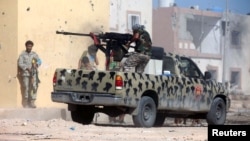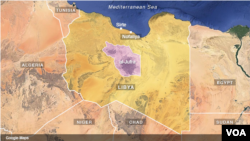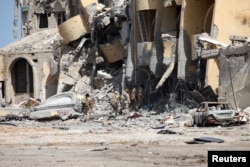As the Islamic State group faces military defeats in Syria and Iraq, the group has an eye on war-torn Libya, hoping to re-emerge there and organize in the country's desert, officials and experts warn.
Siddiq al-Soor, the head of the Public Prosecutor's Office in Tripoli, told reporters on Thursday that IS militants in the country were mostly operating through "a desert army" unit they set up after being pushed out of their stronghold of Sirte on the Mediterranean Sea last year.
"Now they are being monitored in the territories south of Libya," al-Soor said during a news conference.
Al-Soor said IS militants in the desert area were being led by Iraqi national Abdul Qader al-Najdi, also known as Abu Moaz Al Tikriti, with support from other IS leaders, including Mahmoud Al Bur'si and Hashim Abu Sid.
"Most of those leaders were members of al-Qaida and traveled to Syria and Iraq to join the fight before returning to Libya," al-Soor said.
He said Libyan prosecutors obtained information about the whereabouts of the group's desert army from an IS fighter who was wounded and captured after U.S. airstrikes in the Wadi Skir region last week.
Series of strikes
The U.S. military has conducted airstrikes against IS in Libya this week. Two airstrikes 100 miles southeast of Sirte on Tuesday left "several" IS fighters dead, the U.S. Africa Command (AFRICOM), which oversees American military activities on the continent, said in a statement.
Six other U.S. airstrikes last Friday killed 17 IS members and destroyed three vehicles in a desert camp approximately 150 miles southeast of Sirte, according to AFRICOM.
IS considers southeast Sirte an important region for its operations because it is home to several major oil fields like al-Bayda, Mabruk, Bahi and Fida.
A country of about 6.4 million people, Libya descended into chaos in 2011 when an uprising and international intervention led to the overthrow and subsequent execution of dictator Moammar Gadhafi.
The civil war has divided the country into two governments, the U.N.-backed Government of National Accord in Tripoli and the Russian-backed Libyan National Army in Tobruk, with each laying claim to power.
Fragile peace
After continued clashes, the two sides finally agreed on a cease-fire in July. Nonetheless, peace between them remains fragile.
Both sides continue to accuse each other of allowing terrorists to operate under their watch to further their own military objectives, with IS taking advantage of the situation to regroup in the country, according to Libyan militias fighting IS in Libya. They warn that IS is reorganizing in the southern Sirte countryside and the desert valleys and inland hills extending to the south of the country.
U.S. officials have echoed those concerns, adding the terror group is trying to use the spaces to recruit and facilitate the movement of foreign fighters.
"[IS] and al-Qaida have taken advantage of ungoverned spaces in Libya to establish sanctuaries for plotting, inspiring and directing terror attacks," AFRICOM said in a statement on Monday following its last Friday airstrikes.
AFRICOM has estimated that nearly 500 IS fighters remain active in Libya, a decrease from a peak of about 6,000 in 2016.
Anti-IS militias say the remaining IS fighters in the country have been mainly operating in smaller groups at night to avoid being detected. They say the fighters are setting up temporary checkpoints to kill and kidnap those opposed to the group.
An IS attack on a checkpoint 300 miles south of Tripoli in August left nine fighters of the Libyan National Army and two civilians dead.
Threat to Europe
Observers say Libya will continue to remain a hotbed for IS activities and other terrorist groups in years to come because of the divided government.
"They are unable to control their borders, unable to police inside the country effectively, and their large geographic area is relatively easy for not just terrorist elements but also criminal elements to operate across the borders," David Mack, an expert at the Middle East Institute and a former U.S. diplomat to Libya, told VOA.
Mack said the U.S. and EU must not let Libya move to their blind spot, because a stronger IS in Libya would threaten Europe, which is only a few hundred miles away across the Mediterranean Sea.
Jonathan M. Winer, a former U.S special envoy for Libya, told VOA that IS has an eye on Libya for a reason.
"They have been under so much pressure that they have to demonstrate that though they are shrinking and weakening, they still have power, and they want to demonstrate they can do it again in some other locations," Winer said.
He added the U.S. and its allies must provide the necessary help.
"The Libyans themselves did all the fighting and all the dying to get IS out of the region of Sirte, and United States and other countries owe it to the Libyan people to continue to assist them in keeping IS from controlling the Libyan territory."









